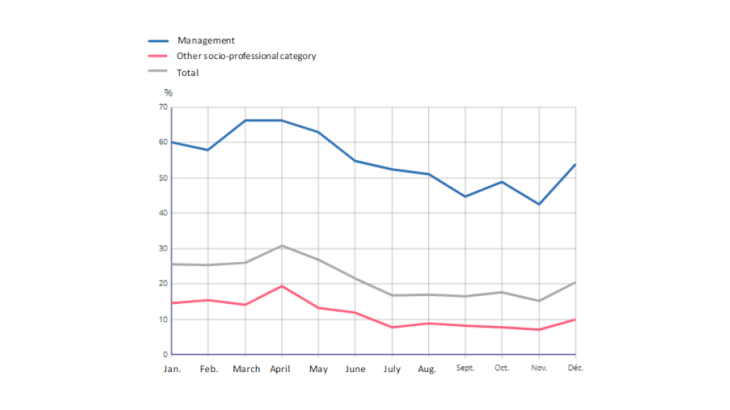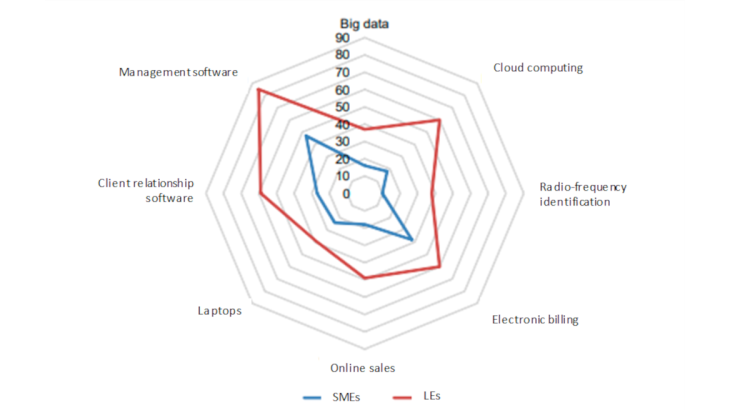The Covid-19 pandemic has accelerated the adoption of teleworking practices. While only 3% of employees turned to teleworking in 2017 (DARES), more than 20% on average used this option each week in December 2021 (see Chart 1). Furthermore, 40% of professions are considered “teleworkable”, mainly in management or self-employed professional positions. This type of arrangement is very likely to last, at least in a hybrid form, with more than 8 out of 10 business leaders hoping to develop teleworking in their organisations on a long-term basis (Association Nationale des DRH).
Teleworking could lead to greater flexibility in labour supply and demand
Teleworking helps businesses to reduce their real-estate expenditure
Thanks to teleworking, businesses do not need to have all their employees on site at the same time. According to the Institut de l’Epargne Immobilière et Foncière (IEIF), teleworking could reduce the office space needed by businesses in Île-de-France by as much as 36%. As real estate represents the second largest corporate expense according to Les Échos newspaper, saving space could free up financial resources. This analysis is confirmed by the Banque de France (Bergeaud and Ray, 2020; Bergeaud and Ray, 2021). This space saving could also facilitate the development of new tools such as the use of coworking or managed office spaces, allowing businesses to rent premises on a short-term basis in order to maximise flexibility. Applying this logic, businesses could then hire workers without having to make office space available to each of them, freeing up new financial resources. This could thus stimulate investment, corporate restructuring and recruitment.
The effects of greater worker flexibility
In addition to the economic benefits for the business, employees could also gain financially against a backdrop of rising energy and real-estate prices. Individuals can break away from the city centres in order to reduce their housing expenses and enjoy a different lifestyle, notably with amenities and without urban congestion. This mobility could lead to greater peri-urbanisation, and even see the emergence of a "doughnut effect” as more jobs become available in the outskirts of the city, thus hollowing out city centres. Indeed, rising numbers of skilled workers in a sector can increase labour demand in the area due to a local multiplier effect, particularly with regard to less skilled positions (personal services, sales, security, etc.). Furthermore, teleworking could contribute to the development of e-commerce or activities in information technology engineering. However, the transportation and accommodation and food service sectors could consequently suffer (DARES).
Ultimately, teleworking could partly eliminate certain material constraints and thus give individuals greater choice when looking for employment. Beyond the greater flexibility that it provides, this new working arrangement also entails a better match between labour supply and demand, which may be reinforced as discrimination according to place of residence becomes more limited (Bunel, L’Horty and Petit, 2016). However, these workers may have to face up to international competition as teleworking partly lifts geographical constraints. This phenomenon is referred to as “white-collar outsourcing” and while it is not the subject of a great many studies, we can imagine an increase in the offshoring of highly teleworkable activities to countries with a cheaper labour pool.
Teleworking can be part of a new dynamic in terms of job creation
When put to proper use, teleworking can boost business productivity
While the conclusions of the various studies of the overall link between teleworking and productivity at the macroeconomic level appear to differ, the fact remains that some businesses can exploit hybrid work as a way to increase their productivity. This gain in productivity is partly due to greater flexibility, giving workers the chance to organise their own working environment and to more easily establish a work-life balance. It is this task of self-management that could result in greater productivity (Godart, Görg and Hanley, 2017). Furthermore, remote working reduces daily commuting times, which account for around 45 minutes on average in Île-de-France. The time saved could be devoted to work (Arntz, Ben Yahmed and Berlingieri, 2020).
Logically, the more a business is properly prepared and has the right tools to embark on its transformation, the greater the benefits of teleworking. Equally, remote working is likely to be more appealing to an individual when she/he has an appropriate working environment, particularly with adequate digital coverage.
Generally speaking, the OECD and the Banque de France assert that there is an inverted U-shaped relationship between the percentage of teleworking and worker efficiency (OECD, 2020; Bergeaud and Cette, 2021). After a certain point, negative effects start to outweigh the positives, particularly as knowledge sharing declines. Businesses must therefore identify the ideal level of teleworking in order to take full advantage of the new possibilities that these arrangements offer. This level may differ from one employee to another, meaning management can be adapted to the skills of the individual.
This new working arrangement can be an excellent opportunity to digitalise certain economic activities
Provided that individuals are properly trained in these developments and that businesses are properly equipped, it would seem that teleworking could boost potential growth. This would be partly driven by increased business digitalisation and better use of information and communication technologies (ICT).

